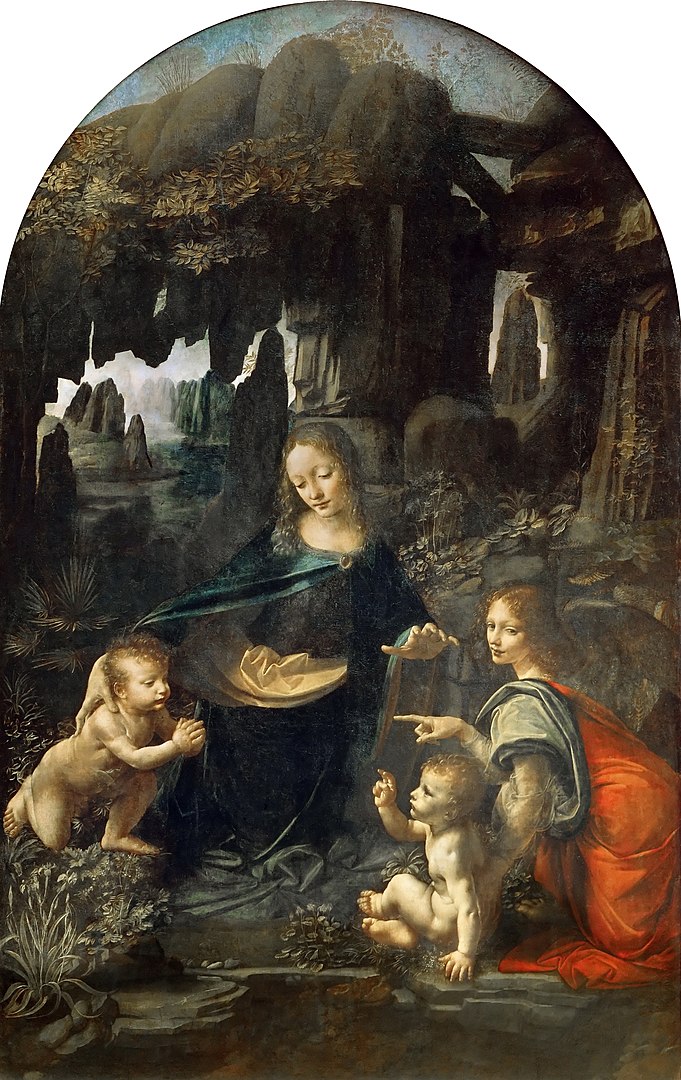
What is happening in Virgin of the Rocks?
The “Virgin of the Rocks,” is a mesmerizing masterpiece by Leonardo da Vinci. It is a story wrapped in mystery, art, and profound symbolism. Created during the High Renaissance, this work has captivated scholars, art lovers, and historians for centuries. To understand its essence, we must delve into the painting’s context, symbolism, and the overarching meaning it conveys.
Historical Context
Leonardo da Vinci began working on “Virgin of the Rocks” in the late 15th century, around 1483, under a commission by the Confraternity of the Immaculate Conception in Milan. The original commission required Leonardo to produce a central altarpiece for the church of San Francesco Grande. Interestingly, two versions of the painting exist: one housed in the Louvre Museum in Paris and the other in the National Gallery in London. Both pieces share similar compositions, but they differ in details, technique, and emotional tone.
The existence of two versions has sparked debates about their creation. The first version, considered more dynamic and dramatic, was likely rejected by the commissioners due to its deviation from traditional religious iconography. The second version, while retaining the central theme, adheres more closely to the expected conventions of religious art at the time.
The Composition and Symbolism
The “Virgin of the Rocks” depicts the Virgin Mary, the Christ Child, John the Baptist, and an angel. Set in a rocky grotto, the scene’s naturalistic backdrop features jagged rocks, delicate plants, and flowing water. Leonardo’s use of sfumato, a technique that creates soft transitions between colors and tones, lends the painting an ethereal quality.
Key Elements and Their Meanings:
- The Virgin Mary: Central to the composition, Mary’s serene expression and protective gesture signify her role as the nurturing mother. Her right hand hovers above John the Baptist, a gesture of blessing and guardianship.
- The Christ Child: Depicted as a playful yet divine figure, Jesus extends a hand of blessing toward John, emphasizing His spiritual authority and role as the Savior.
- John the Baptist: As a child, John appears kneeling in reverence toward Christ. His presence underscores the relationship between the two figures, foreshadowing John’s role as the forerunner of Jesus.
- The Angel: Positioned to the right, the angel gazes directly at the viewer, creating a sense of connection. The angel’s enigmatic smile and pointing gesture guide the viewer’s attention, adding an air of mystery.
- The Rocky Landscape: The grotto symbolizes a place of refuge, mystery, and the divine. The interplay of light and shadow within the rocks enhances the painting’s depth and spiritual atmosphere.
- The Plants: Every plant in the painting holds symbolic meaning. For instance, the presence of the iris and the palm may allude to purity and martyrdom, respectively.
Interpretations and Theories
Scholars have proposed various interpretations of “Virgin of the Rocks,” each adding layers of meaning to the work:
- Theological Symbolism: The painting embodies themes of salvation, divine protection, and the interconnectedness of the biblical figures. The grotto setting may symbolize the womb of the Virgin, a sacred space where the divine and human meet.
- Neoplatonism: Leonardo’s fascination with nature and philosophy may have influenced the work. The harmonious integration of figures and landscape reflects a Neoplatonic ideal of unity between the material and spiritual worlds.
- Esoteric Messages: Some theorists suggest hidden messages and meanings within the composition. For instance, the angel’s pointing gesture and the positioning of the figures could hint at deeper, possibly unorthodox spiritual ideas.
Technical Brilliance
Leonardo’s mastery of technique is evident in every aspect of “Virgin of the Rocks.” His innovative use of sfumato creates a dreamlike quality, blending the figures seamlessly into their surroundings. The delicate rendering of textures, from the softness of skin to the ruggedness of the rocks, showcases his keen observation of nature.
The interplay of light and shadow, known as chiaroscuro, enhances the painting’s three-dimensional effect. This dynamic lighting draws the viewer’s attention to key elements, creating a sense of depth and movement.
The Meaning of “Virgin of the Rocks”
At its core, “Virgin of the Rocks” is a meditation on divine grace, human connection, and the mysteries of faith. The painting invites viewers to contemplate the interplay of the sacred and the natural, the seen and the unseen. By situating the holy figures within a naturalistic setting, Leonardo blurs the boundaries between the divine and the earthly, suggesting that the divine is present in the natural world.
The rocky grotto may also symbolize spiritual refuge and the journey of faith. Just as the figures find shelter within the grotto, humanity seeks solace and meaning in the divine. The presence of water, often associated with purification and renewal, reinforces this idea.
Legacy and Influence
“Virgin of the Rocks” has left an indelible mark on art history. Its innovative composition and emotional depth have inspired countless artists and continue to resonate with audiences. The painting exemplifies Leonardo’s genius, blending scientific precision with artistic imagination.
Beyond its aesthetic appeal, “Virgin of the Rocks” challenges viewers to engage with its layers of meaning. It encourages us to look beyond the surface, to explore the intricate connections between faith, nature, and humanity.
“Virgin of the Rocks” is a timeless exploration of the human spirit and the divine. Through its intricate symbolism, technical brilliance, and profound themes, the painting continues to captivate and inspire. Whether viewed as a religious icon, a philosophical statement, or an artistic marvel, “Virgin of the Rocks” stands as a testament to Leonardo da Vinci’s unparalleled genius and his enduring quest to understand the mysteries of existence.




